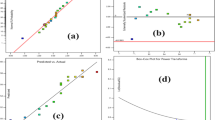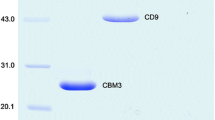Abstract
Cotton fabric samples were treated with a formulation of a total crude Trichoderma reesei cellulase in a two-step procedure. In the first step, samples were treated at a low liquor ratio by padding through the enzyme formulation at 21°C and 55°C with a wet pickup of 100% and batched for 12 h. The samples were then treated at a high liquor ratio (1:25) with an identical enzyme formulation at 55°C, with intensive agitation. The pre-treatment influenced the overall weight loss and rate of hydrolysis in samples, and the protein concentration in the liquor of the second step. The overall weight loss was 25–28% (w/w) in the two-step procedure compared to a weight loss of 22% (w/w) in the one-step batch hydrolysis.



Similar content being viewed by others
References
Cavaco-Paulo A, Almeida L, Bishop D (1996) Effects of agitation and endoglucanase pre-treatment on the hydrolysis of cotton fabrics by a total cellulase. Textile Res J 66:287–294
Döbel H (1999) Cellulosische Stickböden—Enzymatische Entfernung aus Luftstickereien. Textilveredlung 34:20–25
Guebitz GM, Cavaco-Paulo A (2001) Editorial: biotechnology in the textile industry—perspectives for the new millennium. J Biochem 89:89–90
Schimper C, Keckeis R, Ibanescu I et al (2004) Influence of steam and dry heat pre-treatment on fibre properties and cellulase degradation of cellulosic fibres. Biocatal Biotransf 22:383–389
Vasconcelos A, Cavaco-Paulo A (2006) Enzymatic removal of cellulose from cotton/polyester fabric blends. Cellulose 13:611–618
Wood TM, Mahlingeshwara BK (1988) Methods for measuring cellulase activities. In: Wood WA, Kellog ST (eds) Methods in enzymology, vol 160. Academic Press Inc., San Diego, New York, London, pp 87–112
Wood TM (1991) Fungal cellulases. In: Weimer PJ, Haigler C.H (eds) Biosynthesis and biodegradation of cellulose, Marcel Dekker Inc., New York, pp 491–533
Acknowledgments
Authors gratefully acknowledge Christian-Doppler Research Society for financial funding and HTL und Versuchsanstalt Dornbirn, Austria for support in equipment, Roland Wohlgemuth and Reto Schuepbach, Fluka Chemie GmbH, Buchs, Switzerland for support with laboratory chemicals and Avinash P. Manian for proofreading and revision of English.
Author information
Authors and Affiliations
Corresponding author
Rights and permissions
About this article
Cite this article
Schimper, C.B., Ibanescu, C., Keckeis, R. et al. Advantages of a two-step enzymatic process for cotton–polyester blends. Biotechnol Lett 30, 455–459 (2008). https://doi.org/10.1007/s10529-007-9569-1
Received:
Revised:
Accepted:
Published:
Issue Date:
DOI: https://doi.org/10.1007/s10529-007-9569-1




